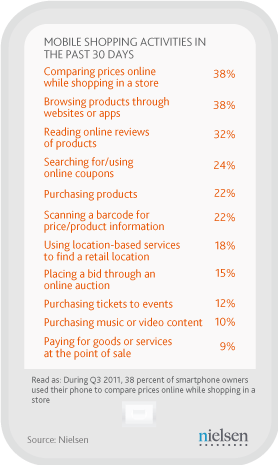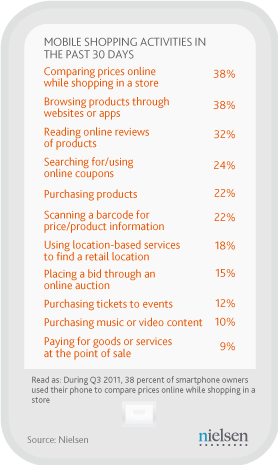
New Research: Smartphone Activity In Retail, And What That Means For Digital Signage
February 22, 2012 by Dave Haynes
Nielsen is advancing some of the findings from its upcoming U.S. Digital Consumer Report, and the data on smartphones should be instructive for companies that target retail environments or have retail end-user clients.
The data backs up conventional wisdom that people whip out their fancy battery-chewing phones not to watch movie trailers and YouTube vids when they are in stores. They use them to help make more informed buying decisions.
 The study found, among many things, that “29 percent of smartphone owners use their phone for shopping-related activities. Top activities among mobile shoppers include in-store price comparisons (38% of mobile shoppers), browsing products through their mobile Web or apps (38%) and reading online product reviews (34%).”
The study found, among many things, that “29 percent of smartphone owners use their phone for shopping-related activities. Top activities among mobile shoppers include in-store price comparisons (38% of mobile shoppers), browsing products through their mobile Web or apps (38%) and reading online product reviews (34%).”
You can see from the results that stuff done in the context of purchasing decisions represents the highest activity level, and it slides down from there. However, a big reason why payment bottoms out the list is that mobile payment at the point of sale is far from common in North America (though routine in places like Japan).
Nielsen suggests mobile apps are key to shifting consumers from browsing products on their phone to making purchases on the spot. Although only 9 percent of mobile shoppers have used their phone to pay at the register, the desire to do so is apparent – 71 percent of app downloaders would be interested in an app that allows them to use their phone as a credit card. iPhone users are more interested in this option than Android users, with over a third (39%) saying they would be extremely or very interested in an app with this ability.
So what does this mean in the context of digital signage? A bunch.
Consumers are clearly using their smartphones to do more than text friends and update their social media accounts when they are out in the retail wild. With smartphone penetration escalating rapidly, the sort of on-the-spot research that is increasingly common will just be the norm.
So, if your digital sign/interactive digital strategy mirrors what people are doing via phone and tablet, that may need a re-think. You want to be working WITH these devices, not competing with them for attention. That’s not a contest you’ll win very often.
So there’s a few things to consider.
Larger screens can drive awareness and usage of retailer-specific apps that will help keep shoppers in the store instead of heading down the street to a competitor with a lower price.
Larger screens can be far more effective driving the brand and emotion of products, whether that’s big cars or little bottles of cologne.
They’re going to be better driving offers because of the pure visual punch not possible in teeny mobile banners and test prompts.
Larger screens address the squint factor. The biggest smartphone screens on the market are a little over 5 inches diagonal. It may seem huge in someone’s hand, but it’s still a teeny screen. While pricing and inventory availability is easy to read on a small screen, trying to get a sense of what a product looks like using an iPhone screen is a little ridiculous. You pinch and zoom, pinch and zoom, seeing bits of an image – all the while eating into your wireless data limit.
Both big and small screens have their place in retail. It’s way too simplistic – never mind flat wrong – to suggest mobile trumps digital signage, or vice versa. Each has a role, and the strategy should involve ways that respect what each other does and what consumers want and how they behave.
What do you think?




Dave, You know what I think. I’ve been under attack for over three years because of my predictions. What we are seeing now is just a small precursor of what’s coming. Word of advice to the digital signage industry: Hold on, you ain’t seen nothin’ yet. Word of advice to digital signage buyers: Learn about mobile so that you can protect your digital signage investment.
Agreed, Dave! The convergence between digital signage and mobile technologies opens the door to an abundance of new advertising possibilities. Retailers should embrace the integration of both tools rather than debating which is best. The key is to tap into each platform’s unique strengths and strike a balance in order to create engaging consumer experiences. When done right, digital signage and mobile can work together to drive home brand messaging and enhance the retail experience in a uniquely interactive way. For more information on digital signage follow us on Twitter @A2aMEDIA.